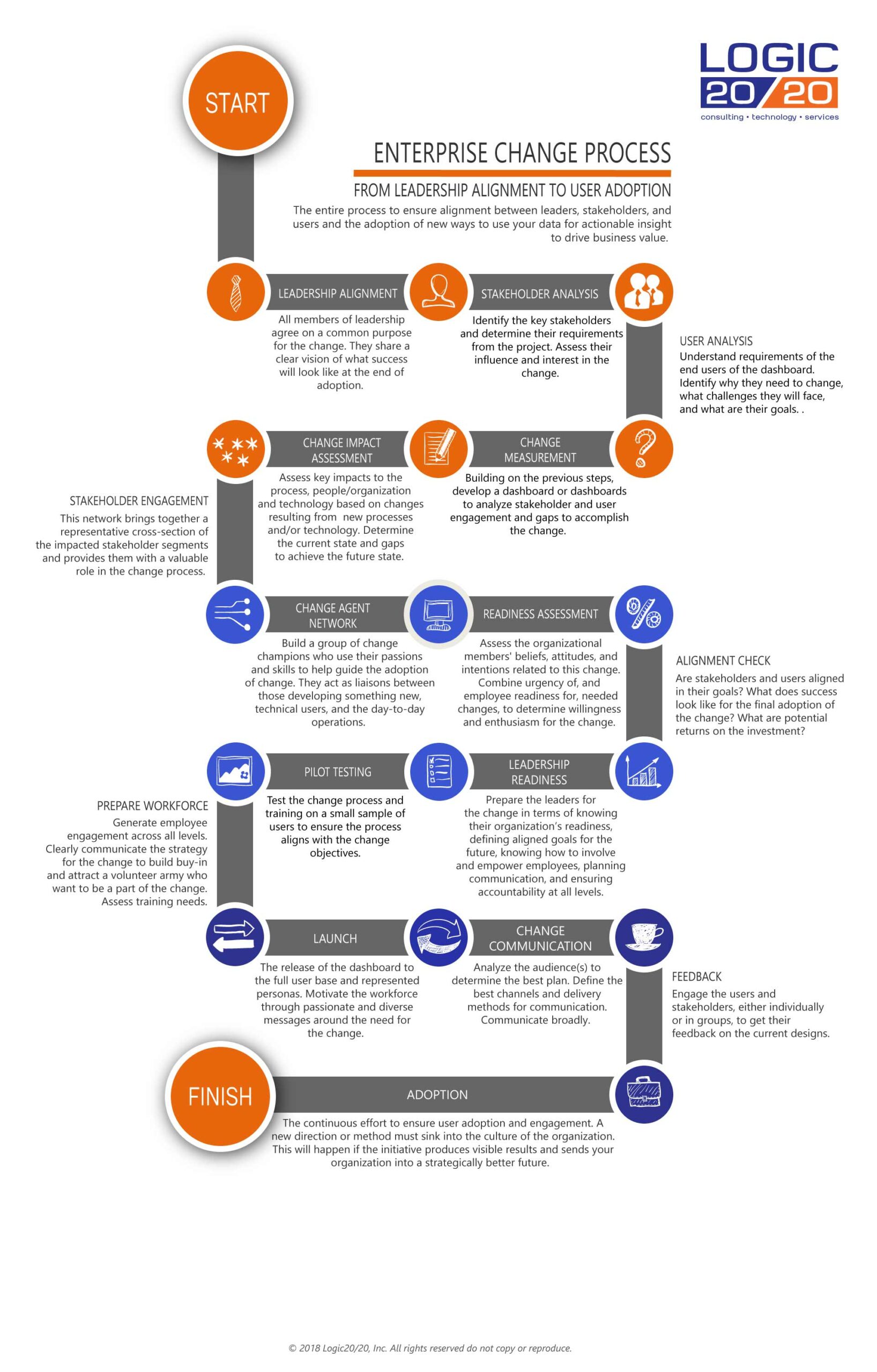5-minute read
Organizational change is equally hard to accomplish. It’s extraordinarily tough for companies to sustain change. What makes some successful while others fall short? For businesses, this comes down to two things: change management and its cousin, change leadership. Though it may come as a surprise, there is a difference between the two. For long-lasting success, you need both, and change management consulting experts are helping business leaders leverage both to achieve their goals.
Change management describes approaches to prepare and support individuals, teams, and organizations in making organizational change. It includes methods that redirect or redefine the use of resources, business processes, budget allocations, or other operations that significantly change a company or organization. Change management consulting uses a set of basic tools or structures to keep change efforts under control while minimizing the distractions and impacts of change.
Change leadership is the ability to influence and enthuse others through personal advocacy, vision, and drive, and to access resources to build a solid platform for change. In the words of Dr. John Kotter, “Change…requires creating a new system, which in turn always demands leadership.” It is difficult to sustain organizational change without proper leadership, and change management consulting teams can help leaders develop the vital skillsets needed to be effective.
So, how can we combine the two into a plan that won’t fail?
Our change management consulting experts have identified five elements necessary for a successful change, each of which requires an equal balance of change management and change leadership:
1. Gain buy-in
Change is a team effort; it can’t be achieved without real participation and enthusiasm from those involved. Preparing for an important change by getting buy-in from only senior management may seem like all you need, but expecting a trickle-down effect to work is asking for trouble. Change management consulting experts know that for long-lasting success, employees at all levels need to buy in early and be convinced of two things: why the change is important and how it can help them. One important thing to remember is that message and delivery are equally important. When people are invited to be part of a conversation, they feel respected and empowered. They can express their thoughts, questions, and concerns—and those with answers are given an opportunity to prevent conflicts and avoid deployment bottlenecks. This exchange of ideas creates a solid foundation for the organization to affect change as a team.
2. Develop true urgency
The desire for change in business involves both external and internal urgency. It’s easy for change-makers to develop external urgency via things like deadlines, financial goals, and expectations, but change management consulting principles incorporate internal urgency, created by effectively communicating the benefit(s) a change will provide. When employees can envision precisely how a planned change is relevant to the success and simplification of their own work, they adjust their behavior and develop true urgency. With this in place, they begin to see results, become advocates for the change, encourage others, and build the type of sustained momentum that results in success.
3. Be thorough
To build momentum for change, it’s important to celebrate early adopters. These employees and their participation can serve as a vision for those not yet on board. However, while it’s easy to get excited at the first glimmer of successful change, don’t let this mini-success lull you and your team into complacency. Declaring victory too soon allows people to slide back into old habits. Instead, continuing with full speed ahead confirms that change is an ongoing process requiring thorough integration and strong commitment from all participants.
All right – feeling overwhelmed? Wondering when you can relax? Well, a good benchmark is when the new process is so well-ingrained that new hires hear of nothing else – not even whispers of the “old way.” We’ve all heard the adage that consistency is key—and any change management consulting pro will affirm that organizational change is no different!
4. Measure properly
Picture this: you’ve hit the gym three times this week and are feeling good about the new machines you used yesterday. Tonight, your friends are all going for pizza, and you know you’ve earned a night out. Sounds good, right? Well, sort of.
Without precise measurement, it’s easy to make assumptions and guesses about the balance of effort and reward. If your goal is to lose weight, your three gym sessions may not actually be enough to offset your pizza, no matter how much sweat you left on the gym floor. The same goes for organizational change, as change management consulting experts will affirm. If you operate based on fuzzy information, your progress ends up being far slower than it could be, and you don’t get the motivation that comes from seeing accurate progress. However, if you track with precision, you’re well-prepared to make informed decisions that push you in the right direction.
It’s equally important to measure properly even before you begin implementing change. If you don’t devote the time required to learn what you need to, you might be stalled by an unforeseen issue, which could dampen both your confidence and resolve, making you give up. Conversely, carefully researching the facts allows you to learn what you know and what you don’t, then acquire the proper tools for executing change effectively—and an experienced change management consulting team can show you the way.
5. Prepare your team
Make sure to include a proper training plan for everyone who will have a new role; don’t assume people will know how to do something differently! While your team is full of smart people, your change management consulting team can help you provide resources that are accessible and regular. It’s natural for people learning something new to want what’s easy, and if you train your team successfully, making them feel like an expert in the new process, they’re more likely to stick with it and advocate it to others. With this confidence in place, they won’t default back to their old habits when training new hires. Instead, they’ll be engaged and excited to teach others the new, improved strategy.
Aside from successful integration of new processes, there’s another gigantic benefit to proper team preparation: employees love feeling valued. Giving comprehensive training demonstrates that you want to invest in your team, that you believe in them, and that you value their contributions. If employees can see that you’re relying on them and that you believe they’re capable, they’re inspired to devote energy to accomplishing shared goals. This shared effort also creates community, further reinforcing all the positives that sustain change.
The five elements above will work for your business goals, but also for your personal ones. Implementing change doesn’t happen overnight, but with proper forethought, careful deployment, and a little help from your change management consulting team, you can achieve long-term success.


Claim your competitive advantage
We create powerful custom tools, optimize packaged software, and provide trusted guidance to enable your teams and deliver business value that lasts.

